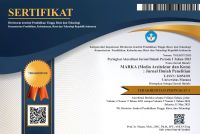Integrasi Bioenergi dalam Desain Taman Kota
Abstract
Bioenergy is a renewable energy source that can be renewed naturally and has a good environmental impact on air quality in urban environments. Urban parks have the potential to integrate bioenergy into an urban context. Design environmentally friendly city parks to be able to produce bioenergy, so that public spaces can double as both open recreation spaces and sources of green energy. The air condition in Lhokseumawe City experiences CO2 pollution and high air temperatures. The aim is to implement bioenergy in gardens through application to plants and trees. Climate change is characterized by extreme rainfall and temperatures. Apart from that, the depletion of the ozone layer is the impact of global warming which is indicated by high air temperatures a global issue. In essence, climate change occurs in all cities. Apart from that, rapid urban development is the influence of the activity and density of the city center which triggers an increase in global warnings and has an impact on thermal comfort. good air quality and thermal conditions in outdoor spaces in urban areas are difficult to find. The presence of public space plays a role as a green open space and a source of green energy and renewable energy and can increase absorption areas. However, the existence of environmentally friendly green open spaces that are capable of reducing global warming cannot be integrated with bioenergy, which is still less familiar and not yet optimal for application, so it is the basic fundamental phenomenon in this research. This research aims to identify thermal quality (CO2, temperature, and wind speed); identify softcape elements, namely plants in RTH, and contribute through integration with the bioenergy approach in RTH as a solution to reduce global warming, especially CO2. This type of research is descriptive using a quantitative approach. The research results show that CO2 levels have exceeded the threshold, resulting in air pollution with high air temperatures. This condition has a very negative impact on the survival of an urban environmental climate. The presence of plant elements as softcap elements has yet to be fulfilled, so certain plants are needed as a solution in producing bioenergy applications.
Downloads
References
Adhianti, R. A. C., Sari, K. E., & ... (2020). Peningkatan Biokapasitas Rth Publik Dalam Upaya Pengurangan Emisi Co2 Ruas Jalan Ranugrati Kota Malang. Planning for Urban Region …, 9(0341).
Antonini, E., Vodola, V., Gaspari, J., & de Giglio, M. (2020). Outdoor wellbeing and quality of life: A scientific literature review on thermal comfort. Energies, 13(8). https://doi.org/10.3390/en13082079
ASHRAE-55. (2017). Thermal Environmental Conditions for Human Occupancy-2017. ANSI/ASHRAE Standard 55, 7, 60.
Coutts, A., & Tapper, N. (2017). Trees for a Cool City : Guidelines for optimised tree placement. Cooperative Research Centre for Water Sensitive Cities, 25.
Febriansyah, A. R., Ergantara, R. I., & Nasoetion, P. (2022). Daya Serap Co2 Tanaman Pengisi Ruang Terbuka Hijau (Rth) Privat Rumah Besar Perumahan Springhill Dan Citra Mas Di Kelurahan Kemiling Permai. Jurnal Rekayasa, Teknologi, Dan Sains, 6(1), 20–31.
Hadi, S. P. (1998). Environmental Development Reform. 23(February), 18.
Kusminingrum, N. (2008). Potensi Tanaman Dalam Menyerap Co2 DAN Co untuk Mengurangi Dampak Pemanasan Global. Jurnal Permukiman, 3(2), 96. https://doi.org/10.31815/jp.2008.3.96-105
Nikolopoulou, M., & Steemers, K. (2003). Thermal comfort and psychological adaptation as a guide for designing urban spaces. Energy and Buildings, 35(1), 95–101. https://doi.org/10.1016/S0378-7788(02)00084-1
Novianti, Y., Ginting, N., & Marpaung, B. O. Y. (2018). Place attachment of the public space in Krueng Cunda. IOP Conference Series: Earth and Environmental Science, 126(1). https://doi.org/10.1088/1755-1315/126/1/012154
Prasetyawan, I. B., Maslukah, L., & Rifai, A. (2017). Pengukuran Sistem Karbon Dioksida (Co2) Sebagai Data Dasar Penentuan Fluks Karbon Di Perairan Jepara. Buletin Oseanografi Marina, 6(1), 9. https://doi.org/10.14710/buloma.v6i1.15736
Putra, B. P., & Nawawi, M. (2013). Vegetasi Sebagai Pereduksi Co 2 Udara Ambien Tepi Jalan Vegetatation for Reducing Co 2 Roadside Ambient Air.
Tukiran, J., Ariffin, J., Naser, A., & Ghani, A. (2016). Cooling Effects of Two Types of Tree Canopy Shape. International Journal of GEOMATE, 11(24), 2275–2283.
UU No 26. (2007).
Welfle, A. J., Almena, A., Arshad, M. N., Banks, S. W., Butnar, I., Chong, K. J., Cooper, S. J. G., Daly, H., Garcia Freites, S., Güleç, F., Hardacre, C., Holland, R., Lan, L., Lee, C. S., Robertson, P., Rowe, R., Shepherd, A., Skillen, N., Tedesco, S., Röder, M. (2023). Sustainability of bioenergy – Mapping the risks & benefits to inform future bioenergy systems. Biomass and Bioenergy, 177(October). https://doi.org/10.1016/j.biombioe.2023.106919
Zhang, X. Y. (2016). Developing bioenergy to tackle climate change: Bioenergy path and practice of Tianguan group. Advances in Climate Change Research, 7(1–2), 17–25. https://doi.org/10.1016/j.accre.2016.06.001
- Abstract 92
- PDF (BAHASA INDONESIA) 59
Copyright (c) 2024 Yenny Novianti, Sisca Olivia, Erna Muliana

This work is licensed under a Creative Commons Attribution-ShareAlike 4.0 International License.







